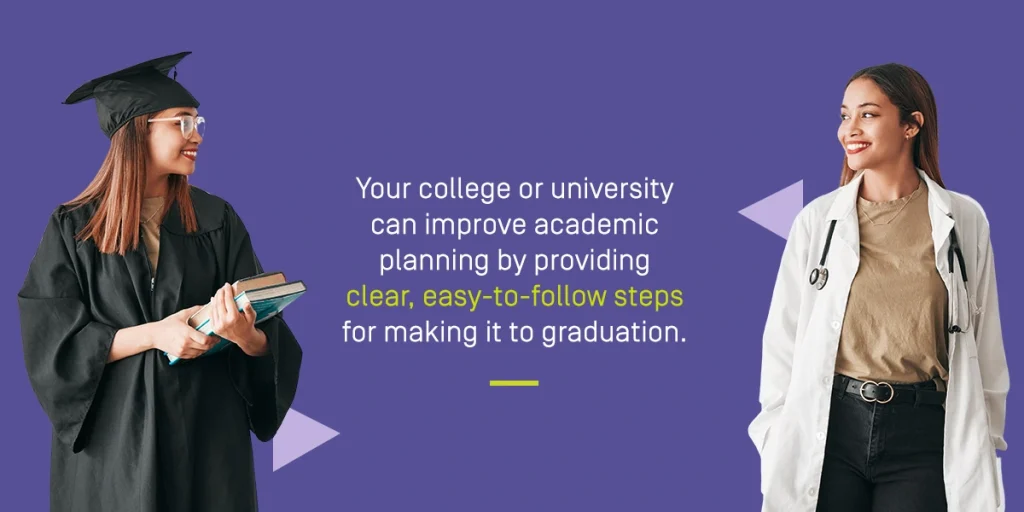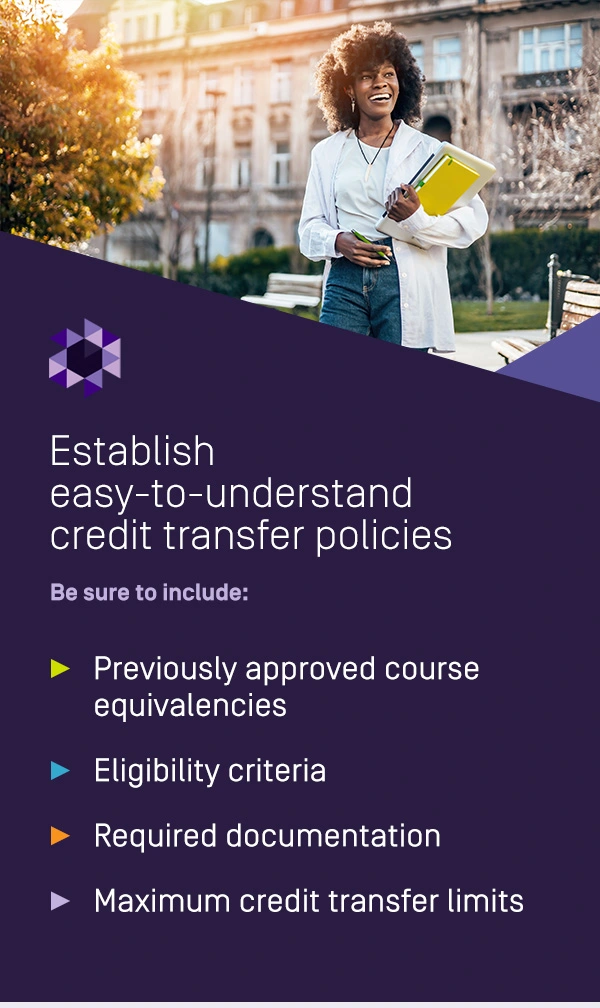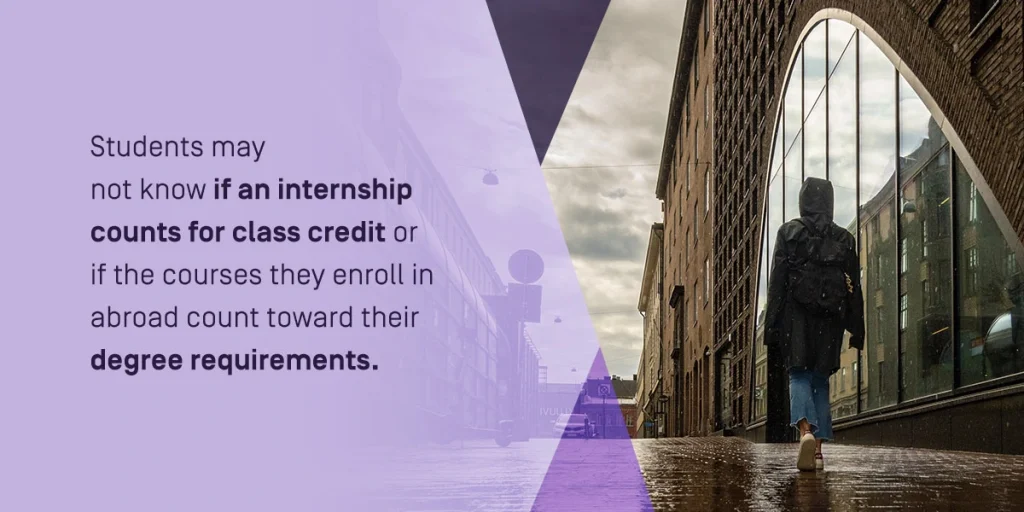




Student academic planning is a huge facet of higher education. The process involves aligning the student body’s individualized learning programs with the institution’s larger mission.
Through targeted academic plans, students can gauge their progress in attaining their degree and make informed decisions about the courses, extracurriculars, and learning opportunities they choose for themselves. Colleges and universities can help their students by streamlining the academic planning process and supporting them with guided pathways to graduate on time.
We are breaking down various ways your institution can improve student academic plans to enhance their experiences and help them make it to graduation day with ease.
Your higher education institution can support student success by taking steps to improve academic plans and guide student progress toward graduation.
Explore the following tactics to foster more effective and beneficial planning processes:
Personalized advising is one of the best ways to support your students and ensure they have academic plans that align with their career goals. Higher education institutions can pair students with dedicated advisors to offer guidance on course selection based on individual interests and needs.
Advisors can be individuals who serve as professors, counselors, or department chairs at your institution. They should understand how your degree programs work and be able to help students choose courses that help them earn their degree in a certain timeframe.
Students can use their academic advisor as a key resource in course planning. They can email or schedule a meeting with their counselor when they have questions about certain classes or degree requirements, giving them more support and guidance.
Encourage your institution’s advisors to reach out to their advisees at least once per semester to ensure students have an academic plan that suits their needs and fulfills degree requirements.
Advisors should monitor student performance throughout the year and provide additional support for individuals struggling in a course or with attendance. Support may include sharing tutoring services or career development opportunities. Early intervention can help students get back on track to continue their academic plans.
Another way your college or university can improve academic planning is by providing clear, easy-to-follow steps for making it to graduation.
Every higher education institution has performance and participation criteria students must meet to earn their specific degree. You can help your students understand the completed courses, deadlines, and requirements they need to follow using roadmaps and guided pathways for academic planning.
Your institution should create individualized tracks for each degree program they offer and inform students of the necessary guidelines for completing their course load, internships, and projects in the desired time frame.

Some of the information a degree roadmap should contain includes:
Course selection is often challenging and highly competitive for students. Limited spots, conflicting class times, and availability can complicate scheduling and ultimately extend the time earning a degree takes.
Fewer than half of college students graduate on time, so many higher education institutions actively seek ways to streamline course selection and make in-demand courses more available. Strategic planning is key to ensuring your students have plenty of opportunities to enroll in the classes they need to fulfill their degree requirements without potentially having to overload their schedule, take courses out of order, or enroll for an extra semester or academic year.
Your college and university can benefit from monitoring the demand for each course and asking students for feedback regarding any challenges with scheduling. Gathering data about course enrollment will offer great insight into things like:
Performing a data analysis can help your institution properly allocate resources to offer students the required courses when needed. Collaborate with each academic department to determine what they need to provide students with the courses they require, such as additional staff, teaching assistance, or classroom space.
Successful academic planning involves several factors and moving parts. Many students, especially those in their first year, struggle to understand how to fulfill their degree requirements on their own. Higher education institutions should provide instruction on academic planning processes, such as course selection or monitoring degree progress, with digital tools.
Your institution can provide helpful resources in various ways. Consider hosting workshops, posting online resources, or creating mentorship programs to help students learn more about making informed and strategic academic decisions.
Establishing a mentorship program is a great way for colleges or universities to ensure their students have the resources needed to succeed. Carefully select alumni or experienced students who can offer helpful guidance to the newer students on how to master academic planning. Pair mentors and mentees from the same degree program can be highly advantageous, allowing students to get a first-hand account from someone who has experience navigating the same classes and requirements.
Providing instruction and support for academic planning is important because it helps students make smarter choices that allow them to complete their requirements and graduate within their desired timeframe, typically between four and six years.
A simple way to improve student academic planning at your college or university is to create clear, easy-to-understand policies for transferring credits. Every institution has its own rules regarding the credits they accept towards degree completion from advancement placement examinations or classes offered by different institutions.
For students, navigating course equivalencies and maximizing the number of credits that transfer can be tricky. Colleges and universities can streamline the process by establishing policies in a concise and straightforward way. Avoid including excessive technical jargon that students may misinterpret. Instead, outline the rules in plain, easily understandable language.

Post your credit transfer policies in an accessible place, such as your website or in your student handbook. Be sure to include:
You can also streamline the process by developing a set of protocols for evaluating course equivalencies that thoroughly explore the following:
Having these evaluation standards will help your institution quickly determine if a course from another school is an adequate replacement for a class you offer.
Educating your faculty, advisors, and other student support staff on your institution’s credit transfer policies can be highly advantageous. With more people who are well-versed in how your transfer processes work, your students will have the resources they need when questions or concerns arise.
If your higher education institution wants to improve academic planning and make envisioning the future easy for your students, investing in digital degree mapping tools is an incredible solution. These tools offer insight into each student’s academic journey, helping them monitor their progress toward fulfilling their degree requirements.
Some of the key uses and benefits of degree mapping tools include:
In addition to these helpful uses, students can also take advantage of degree mapping tools to explore “what-if” scenarios. These may include visualizing the impact of switching majors or adding a minor. It may also help them determine if their current path is right for them.
Students can use degree mapping to plan for future semesters and ultimately make more informed decisions about their academic pursuits.
Another way your higher education institution can improve student academic planning is by incorporating additional educational opportunities, like studying abroad or participating in research, into your processes.
For many students, gauging the value of special educational pursuits can be challenging. They may not know things like if an internship counts for class credit or if the courses they enroll in abroad count toward their degree requirements. Confusion around additional educational opportunities can deter your student body from participating. Instead, make it easy for your student to take part in these programs and diversify their learning.

The following are some practical tips for integrating special opportunities into your institution’s academic planning:
For students, attending a college or university helps them set them up for success with a well-paying job after graduation. In fact, the unemployment rate is far lower for individuals with a bachelor’s degree. Your higher education institution can help students secure work and plan for the next phase in their education.
Academic planning can extend beyond a student’s undergraduate workload. It can help them understand and explore potential graduate degrees and the building blocks needed to get into those programs.
Your institution can streamline the transition from undergraduate to graduate student, further encouraging more of your learners to continue pursuing their educations. Provide insight into higher-level programs and the prerequisites needed so students can set up their undergraduate course load to support their next degree. Again, degree mapping tools can be an invaluable asset to these processes.
Your higher education institution can improve and optimize its academic planning processes by prioritizing a collaborative approach that includes all major faculty members and departments.
Your entire staff should deeply understand each student’s academic plans and degree roadmaps. You can help them learn more about the process and how to support their student with workshops, webinars, or other learning opportunities. Teach them about effective advising and how to use your institution’s degree mapping tools to visualize future plans. The more people who can assist with and support academic planning, the better off your college or university will be.
Ask students and staff for feedback about these processes. Encourage them to discuss and explore new ways to improve different processes, such as curriculum development, course sequencing, and credit transfer.
Your college or university can boost its academic planning by applying the principles of continuous improvement. Regularly assess your processes and identify opportunities for growth.
The key to creating the most effective and beneficial academic plans is to continuously fine-tune and edit your operations to meet higher standards. Your institution can begin by gathering feedback from your student body and faculty. Ask them to identify potential areas of improvement from their perspective.
Use these insights to gauge the effectiveness of your academic planning processes, and always seize the chance to make your initiative more student-friendly and intuitive.

If your higher education institution is interested in boosting student academic planning, turn to Watermark. We designed our software specifically to enhance how colleges and universities support their processes and empower student success.
Our solutions give your institution access to valuable data that can drive decision-making and continuous improvement efforts. Whether you need help with curriculum planning or preparing for accreditation review, we have the tools needed to help your college or university thrive.
Request a demo of the higher education institution software from Watermark today.
























































































































































































































































































































































































Submit this form to schedule a meeting with one of our reps to learn more about our solutions. If you need customer support instead, click here.